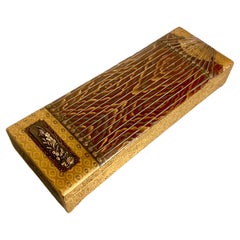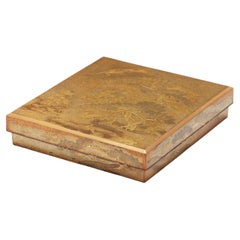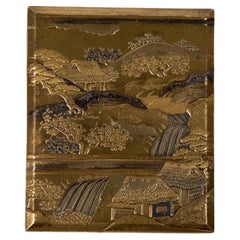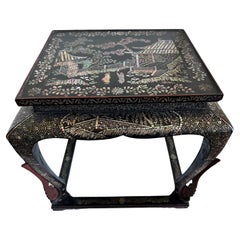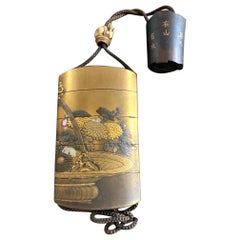Japanese Lacquer
to
18
13
31
54
137
92
2
51
16
7
7
1
6
2
1
3
3
1
28
17
13
5
4
54
50
31
19
3
31
31
31
Period: 18th Century
Place of Origin: Japanese
Japanese Lacquer Writing Box, Suzuribako, Edo Period, 18th Century, Japan
Located in Austin, TX
An exceptionally fine and unusual Japanese lacquer writing implements box, suzuribako, in the form of a zither, koto, Edo Period, 18th century, Japan. With a modern wood storage box,...
Category
18th Century Edo Antique Japanese Lacquer
Materials
Gold, Silver, Copper
Antique Japanese Ink Stone Maki-e Lacquer Box Suzuribako Edo Provenance
Located in Atlanta, GA
A Japanese ink stone box (known as Suzuribako) with exquisite maki-e decoration from Edo period (circa mid-18th century). The box features a rectang...
Category
18th Century Edo Antique Japanese Lacquer
Materials
Wood, Lacquer
Antique Japanese Lacquer and Inlay Kang Table from Ryukyu Island
Located in Atlanta, GA
A small low table with lacquer and intricate mother-of-pearl inlay design from Ryukyu Islands kingdom circa 17-18th century. Ryukyuan kingdom was used to be an independent island cou...
Category
18th Century Edo Antique Japanese Lacquer
Materials
Mother-of-Pearl, Lacquer
Japan lake landscape kobako box lacquer - Edo
Located in PARIS, FR
Rectangular kobako box in takamaki-e and kirigane gold lacquer circled with pewter depicting a lake landscape. Inside and back of the box in nashi-ji lacquer.
Japan – Edo period (16...
Category
18th Century Antique Japanese Lacquer
Materials
Gold
Antique Japanese Lacquer and Inlay Table from Ryukyu Islands
Located in Atlanta, GA
A small square-form table with lacquer and intricate mother-of-pearl inlay design from Ryukyu Islands kingdom circa 17-18th century. Ryukyuan kingdom was used to be an independent is...
Category
18th Century Edo Antique Japanese Lacquer
Materials
Mother-of-Pearl, Lacquer
Antique Japanese Inro by Shigehide Edo Period
Located in Atlanta, GA
This exquisite four-case lacquered inro was dated to the latter part of 18th century to early 19th century (Edo period) and made by Shigehide. The opposite sides of the inro together features a lavish flower arrangement in a bamboo basket (ikebana). The detailed craftmanship was a true pleasure to behold. Mostly Takamaki-e (high relief) were used to texturize the delicate petals of the chrysanthemums, on which different shades of gold were used to create contrast. Raden (mother of pearl) shells were also used to highlight some leaves, rendering the piece an interesting balance of color and material. The interior was completed in a mottled gold finish. It was signed Shigehide on the bottom with a Kao. There is a small carved rabbit ojime bead...
Category
Late 18th Century Japonisme Antique Japanese Lacquer
Materials
Wood, Lacquer
Pair of Fine Japanese Export Lacquer Cutlery Knife Boxes, 18th Century
Located in Amsterdam, NL
A pair of fine Japanese export lacquered cutlery boxes
Kyoto or Nagasaki, late 18th century
H. 33.5 x W. 24 x D. 21 cm
The bow-fronted boxes with sloping lids flat at the top are made of hinoki wood (Cypress), coated with Japanese paper and decorated in lacquer with scattered gold birds and flowers on a nashiji background. The Japanese mounts are made of copper and both boxes still have internal partitions to keep the cutlery upright.
The form of these boxes is similar to a pictorial-style knife box in the collection of the Groninger Museum (inv. 1989- 347), dated between 1730 and 1780, but the style of the decoration is more like that on a knife box in the Peabody Essex Museum in Salem (inv. E62271), which was brought to Salem by James Devereux, Captain of the Franklin, in 1799.
Provenance:
Henriette Jeane Christine van Neukirchen, called Nyvenheim (1807- 1849) and Nicolaas Johan Steengracht van Oostcapelle (1806-1866), thence by descent to the last owners, Ludolphine Emilie baronesse Schimmelpenninck van der Oye (1944) married in 1969 to Roland Daniel van Haersma Buma (1944), the last residents of castle Duivenvoorden near Voorschoten and the great-great-granddaughter of Nicolaas Johan Steengracht van Oostcapelle.
There is no evidence that Nicolaas Johan himself, or any of his or his wife’s ancestors had ever been in Japan. However, Nicolaas’ grandfather (Nicolaas Steengracht, 1754-1840) was a director of both the VOC and WIC (West Indies Company...
Category
Late 18th Century Antique Japanese Lacquer
Materials
Silver
Exquisite Japanese Lacquer Maki-e Hand Box Kobako Edo Period
Located in Atlanta, GA
An early Japanese lacquer Maki-e decorated kobako (small storage box) circa 18th century (Edo period). Based on its form and size, this kobako was possibly used as a Chabako to store the accoutrements for chado (tea ceremony). The lidded box is of rectangular form with bevel design on all edge that softens the appearance. The entire surface was densely covered with a background of nashiji. Elaborate Maki-e techniques were used on each side to showcase a distinct landscape or floral design within a cartouche panel. On the surface of the lid, a mountainous landscape rises from the edge of the water. The poetic composition is akin to a traditional ink scroll...
Category
18th Century Edo Antique Japanese Lacquer
Materials
Lacquer
Antique Japanese Lacquer and Inlay Box from Ryukyu Island
Located in Atlanta, GA
A lacquer presentation box with mother-of-pearl inlays from Japanese Ryukyu Islands circa 17-18th century. The lidded box in rectangular form with rounded corner is a classic example...
Category
18th Century Japonisme Antique Japanese Lacquer
Materials
Mother-of-Pearl, Lacquer
Japanese Lacquer Maki-E Scroll Box Fubako by Kansonsai Edo Period
Located in Atlanta, GA
A Japanese lacquered wood fubako (a box to store document or small scroll painting) circa late 18th century of Edo period. The rectangular box features a deep lid with rounded corners and recessed mid-edge and a lower box with two bronze medallion rings and tasseled silk ties. The surface of the fubako was elaborately decorated with hiramaki-e and a low takamaki-e on a mottled Mura-nashiji background. The motifs on the lid depict branches of Japanese pine with finely rendered needles on the lower part; on the upper part, it showcases fruited persimmon branches. Two different shades of gold fundame were used to contrast the design and augmented by scattered gold kirigane to highlight some of the leaves. The design continues and cascades down to all sides of the lid as well as the walls of the box. The two bronze medallions appear original to the box and the silk ties show significant fading from the age. This Fine fubako is signed on the lower wall "Kanshosai" in Kanji with a kao mark. All the trims were finished in gold fundame and the interiors a dense nashiji in gold.
Kanshosai is the mark of the distinguished lacquer artist Lizuka Toyo I who also signed his work "Toyosai". He was active in the second half of the 18th century during Edo period, employed by Hachisuka Shigeyoshi (1738-1801), daimyo of Awa on Shikoku Island. Although most survived work bearing his marks are inros, he was also known to decorated trays and other larger objects...
Category
Late 18th Century Edo Antique Japanese Lacquer
Materials
Wood, Lacquer
Japanese Samurai Abumi Stirrups Lacquer Edo, 18th Century
Located in Dallas, TX
Japanese Samurai Abumi Stirrups lacquer Edo late 18th century, early 19th century.
Measures: 12 inch length, 10 inch height, 5.5 inch width.
AVANTIQUES is dedicated to providing an...
Category
Late 18th Century Edo Antique Japanese Lacquer
Materials
Iron
Inro in black and gold lacquer with a proeminent chrysantemum flower motive
Located in PARIS, FR
Two compartments inrô in black lacquer, hira maki-e and mother-of-pearl inlay on a hirameiji background, decorated with a bouquet of chrysanthemums in a small purse, a hoe on the other side, and a fluttering butterfly which can be found on both sides. The interior is in hirameiji lacquer. The ojime is a drum made out of black lacquer and ivory with a mother-of-pearl inlay. The Manjû netsuke...
Category
Mid-18th Century Edo Antique Japanese Lacquer
Materials
Gold
Japanese inro box in black and gold lacquer with a decor of snowy landscape
Located in PARIS, FR
Inrō with four boxes in black and gold lacquer, representing a person in a pavilion in a snowy landscape with mountain on the background. Realised in maki-e on black lacquer with sma...
Category
Late 18th Century Edo Antique Japanese Lacquer
Materials
Gold
Japanese landscape pine kobako box Edo period 18th century
Located in PARIS, FR
Rectangular black and gold lacquer kobako box decorated with pine trees in a mountain landscape in takamaki-e, kirigane and hiramaki-e lacquer. Background in nashi-ji lacquer. Surmou...
Category
18th Century Antique Japanese Lacquer
Materials
Gold
Japanese inro of the edo period adorned with a landscape houses near a lake
Located in PARIS, FR
Inrō with four gold lacquer compartments, decorated with a lake landscape. Accompanied by a bronze ryusa manju.
Small boxes formed of compartments that fit one on top of the other, i...
Category
Late 18th Century Edo Antique Japanese Lacquer
Materials
Gold
Extremely Japanese Rare Lacquer Plaque Depicting Russian St. Petersburg
Located in Amsterdam, NL
An important Japanese lacquer Maki-É Panel Depicting St. Petersburg on the River Neva, with the winter palace on the left and the academy of science on the right, 18th century.
Nagasaki, 1780-1800
In black lacquer on copper, the front decorated in maki-é, the back inscribed, Vue Perspective des Bords de la Neva en descendant la Rivière entre le Palais d'hyver de sa Majesté Impériale et les batiments de l'Académie des Sciences à St Petersburg in gold and inlaid with flowers in mother of pearl.
Measures: H 23 x W 39 cm
The present plaque is identical to one in the Museum of Japanese History in Sakura and another one in the Museum of Peter the Great in St. Petersburg. (see: Oliver Impey & Christiaan Jörg, Japanese Export Lacquer, 1580-1850, p. 52-53)
This last one was given to Catherine the Great in 1794 by the Swedish medical doctor Johan Arnold Stutzer who had served with the VOC in Deshima in 1787-1788. Apparently, such plaques were not unique and may have been made in several copies. This was certainly the case with the smaller lacquer oval portrait medallions (see for instance Uit Verre Streken, June 2017, no. 62)
The scene of St. Petersburg was copied from an optical print taken by Stutzer to Japan, as shown by Yasumasa Oka of the Kobe City Museum. Stutzer in his diary writes: “I am the first to bring them (i.e. the Japanese) original pictures such as a view of St Petersburg and of Rudolf XV on horseback and try to have them made (in lacquer). According to the Japanese, it is the first time that these two pictures will be copied. Other products that I also ordered, for example, pictures of sea battles, are also appreciated as absolute masterpieces”.
For two lacquered plaques depicting the sea battle of Dogger Bank in 1781 between the Dutch and the English navies, see Uit Verre Streken, December 2013, nr. 39 and March 2015, nr 56. Johan Strutzer at the same time also presented six beautiful Japanese glass telescopes to Catherine the Great of Russia, like the two Japanese glass telescopes illustrated in Uit Verre Streken, March 2015, item 59 and 60 and the one in the Kobe City Museum (illustrated in: Japan Envisions the West, 16th-19th Century Japanese Art...
Category
Late 18th Century Antique Japanese Lacquer
Materials
Copper
Japanese peony basket lacquered box Edo
Located in PARIS, FR
Eight-sided, flared shaped lacquer kobako box, following the decoration on the lid depicting a basket of flowers, composed of peonies and chrysanthemums in gold takamaki-e and hirama...
Category
18th Century Edo Antique Japanese Lacquer
Materials
Gold
Japanese Bundai or writting table in gold lacquer with a decor of lake landscape
Located in PARIS, FR
Rectangular bundai writing table on four legs in gold lacquer with black highlights on a nashi-ji background. The top is decorated with a lake landscape with plum trees, pine trees a...
Category
Early 18th Century Edo Antique Japanese Lacquer
Materials
Gold, Bronze
Japanese lacquered Inro chrysantemum
Located in PARIS, FR
Beautifull Inro of three compartments made in kinji lacquer with an hiro maki-e
ornament chrysanthemum flowers of gold and silver lacquer. Inside is in fundame
lacquer.
Signed by J...
Category
Mid-18th Century Antique Japanese Lacquer
Materials
Lacquer
Japanese Namban Chest adorned with cylindrical motives and mother of pearl inlay
Located in PARIS, FR
Small namban style chest with a semi-cylindrical lid made of black lacquered wood (urushi) with gold lacquer (maki-e) and inlaid with mother-of-pearl (raden).
Mon style decoration (...
Category
Mid-18th Century Antique Japanese Lacquer
Materials
Lacquer, Mother-of-Pearl
Japanese Kobako box in the form of a furoshiki present in gold and black lacquer
Located in PARIS, FR
Rectangular and flat lacquer Kobako (small box) representing a furoshiki knot seen from above. Fundame background, furoshiki in takamaki-e with floral pattern, inside the folds of th...
Category
Late 18th Century Edo Antique Japanese Lacquer
Materials
Gold
Japan kobako box lacquer samurai - Edo
Located in PARIS, FR
Takamaki-e and kirigane lacquer kobako box depicting two samurai entering an enclosure. Four guards block their access. The side is decorated with cherry blossoms in maki-e lacquer o...
Category
18th Century Japonisme Antique Japanese Lacquer
Materials
Gold
Japanese golden kobako flowers Edo period 18th century
Located in PARIS, FR
Quadrangular kobako box decorated with flowers in gold and blue lacquer with aogai inlay. Lid and sides in fundame lacquer, underside and interio...
Category
18th Century Japonisme Antique Japanese Lacquer
Materials
Gold
Japanese Sagemono Inro box with a maki-e decor of a Samuari in a lake landscape
Located in PARIS, FR
Inrô in gilded lacquer according to the takamaki-e, hiramaki-e and kirigane techniques, with five squares of a mountain lake landscape.
On the first side, there is a man on horsebac...
Category
18th Century Edo Antique Japanese Lacquer
Materials
Gold
18th Century Japanese Lacquer Writing Box and Tray Set
Located in Hudson, NY
Wheels Submerged in flowing water motif, believed to be a subject popular in samurai families. Example of the same subject matter in Tokyo National Museum.
Category
18th Century Antique Japanese Lacquer
An oval Japanese export lacquer tray
Located in Amsterdam, NL
An oval Japanese export lacquer tray decorated with the alliance of the coats of arms of the Mooyaart and Pauw families
Edo-period, circa 1798
L. 51.5 x B. 37.5 x H.3.2 cm
This tra...
Category
18th Century Antique Japanese Lacquer
Materials
Lacquer
Edo Maki-e Japanese Box
Located in Brescia, IT
Japanese box with lacquer lid finely decorated with Maki-e, dating from the 18th century, mid-Edo period.
The box is of special size to preserve important calligraphy.
All sides of ...
Category
Late 18th Century Edo Antique Japanese Lacquer
Materials
Gold Leaf
Black and Gold Lacquer Suzuribako 'Writing Set'
Located in PARIS, FR
Black and gold lacquer suzuribako (writing set) in takamaki-e on a nashi-ji background representing two tigers near rocks, bamboos and plum blossoms in a night landscape. Inside of the lid with a lake landscape.
The interior of the suzuribako is composed with an inkstone, topped by a copper water bucket in the shape of a chrysanthemum on the left side, with a brush and a small knife. It includes in the right part a storage compartment.
Inscription under the inkstone "Inkstone made by Nakamura Chobe".
Although the tiger is not native to Japan, it has a high symbolic. The figure of courage was introduced by Buddhism from China. According to the Chinese tradition, the tiger is from one of the stars of the Great...
Category
Late 18th Century Antique Japanese Lacquer
Materials
Lacquer
Lacquer Potpourri
Located in Stamford, CT
Lacquer Potpourri box and cover with ormolu mountings from 18th century Directoire Japan/ France.
Category
18th Century Antique Japanese Lacquer
Materials
Lacquer
18th Century Japanese Altar Table
Located in New York, NY
This lacquered 18th century Edo period altar table was probably made for the private shrine of an aristocratic home. There, it would have been placed before an image of a deity, and ...
Category
Early 18th Century Edo Antique Japanese Lacquer
Materials
Brass
Japanese, Black Lacquer, Chrysanthemum Shaped Incense Burner 'Koro'
Located in Hudson, NY
With chrysanthemum motif and a gilded bronze lid. Includes unsigned collector's box. Interior measurements: 7 1/2" opening, 5 1/4" deep.
Category
Late 18th Century Antique Japanese Lacquer
Materials
Lacquer
